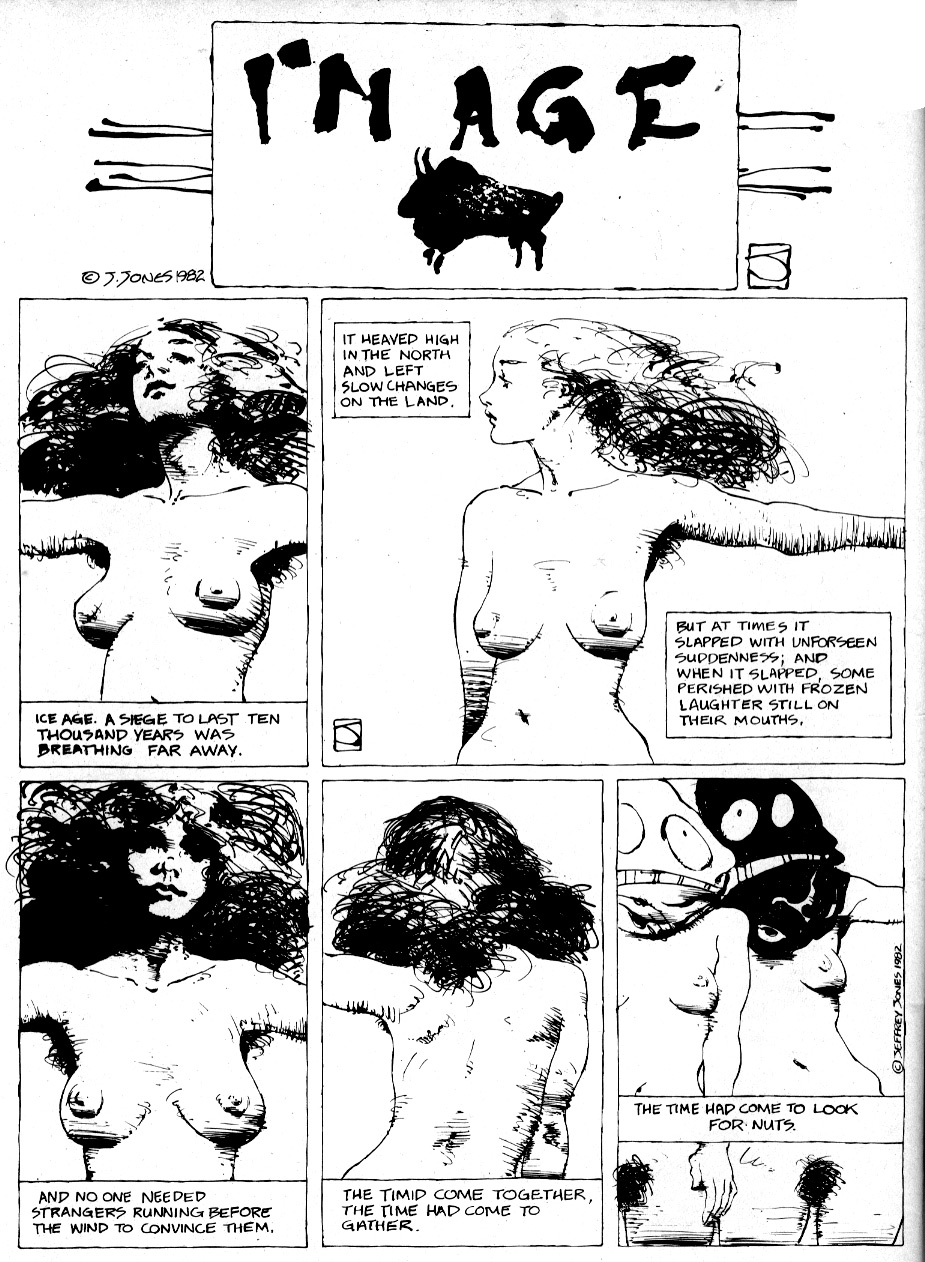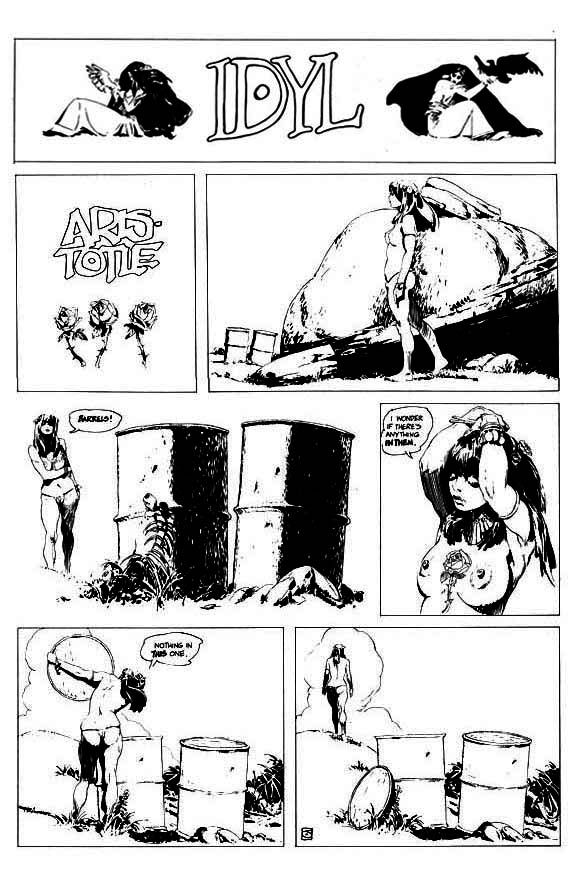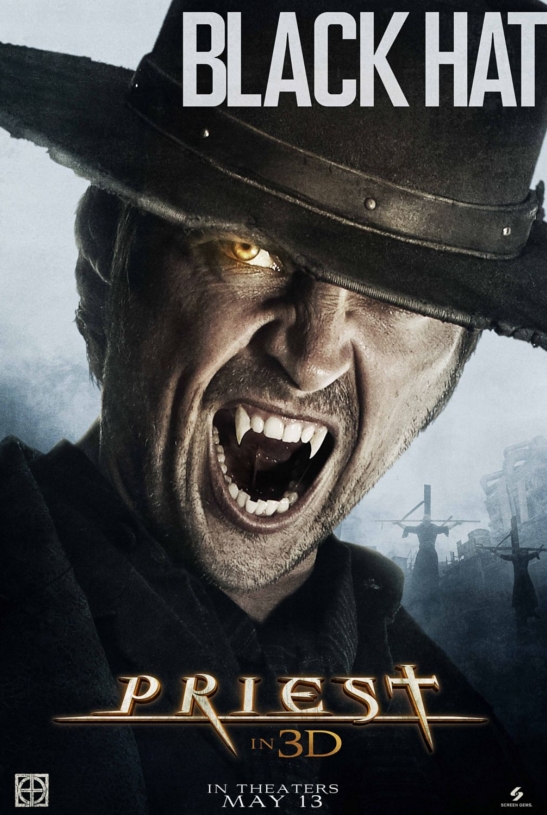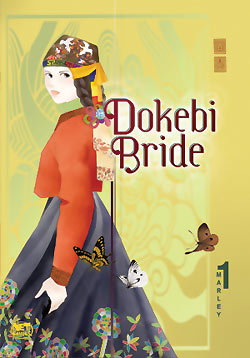The late Jeffrey Catherine Jones (authorized website
here) was not only one of the best painters in North America, she was one of the best draftsmen of the North American comix scene. Idyl and I’m Age, which appeared in the National Lampoon and Heavy Metal, were high-water marks in the now-ebbing comix cult of beautiful draftsmanship. The modern comix renaissance, at least in North America, still prefers to focus on story instead of art and younger readers might be surprised by the bravura virtuosity of Jones’ work. She demonstrated over and over that Beauty was not a shell to put stories into, it could be the story itself.
Why are so many contemporary comix so ugly to look at? Why is there so little pleasure in drawing anymore? Comix artists take such pains in devising interesting, clever plots but visually they’re often rather … disinterested might be the politest way to put it. Perhaps minimalism is the new baroque and Beauty is passé; perhaps it’s a business decision, drawing with one eye on the clock and not worrying about giving readers full value for their money.
Some of these readers are probably wringing their hands over this insinuation that Beauty can be objective. Doesn’t this author know that self-expression has no rules, that we’ve evolved into a brave new world where you can just do it® and be all that you can be® and have it your way®?
But the Bitch Goddess of Art is sparing with her favors and she accepts only one sort of offering at her infamous altar: the development of talent through endless study and practice. An abundant faith in oneself, by itself, means nothing to her, especially in these times when everyone’s above average. Good draftsmanship requires knowledge, skill and a faith in Beauty. The latter is not as subjective as some think. It’s wired into our genes; our eyes and hands do it instinctively if circumstance lets them. And this is not about merely looking pretty. On the contrary, Beauty in art is always harmonious, even when the subject is grotesque or ugly.
Jeffery Catherine Jones’ comix were few but extraordinarily beautiful. She moved fast around slow shapes, letting the physical happiness of drawing suffuse every mark she made on paper. The contrast of loose gestures atop thoroughly composed panels gave her pages a languid, musical dissonance, the connoisseur’s dissonance of Betty Carter or Leos Janacek in their late prime. And unlike most of us ink-stained wretches, her inking and draftsmanship were seamless and in effect, the same thing. This economy of means is the very essence of good draftsmanship.
Making and recognizing good draftsmanship means possessing what’s called a good eye, the ability to see the universal grammar of the visual world. A good eye is not wholly intuitive, it needs to be nurtured through constant exposure to good art.
And there’s the rub — never before in human history have so many artists been so unrelentingly exposed to so much visual rubbish from childhood onwards. As adults, they’re doomed to making marks on paper which are devoid of visual meaning. This is no accident, it is marketing. If one exposes kids to nothing but crap, they will grow up loving crap, talking fervently about crap and passionately defending its crappy reputation, usually with an obligatory dollop of hipster irony. This pop-culture irony, unlike its literary ancestor, reveals nothing of interest though, for it’s a stance without meaning or history or even relevance.
We are what we look at. If we look at garbage we will make garbage and in time, the cycle will close and become self-perpetuating, an endless karmic hell of breakfast-cereal cartoon super-heroes and high-school yearbook doodlings papering over the abyss of a forgotten, glorious past.
Jones’ comix drew deeply from the heady well of fin de siècle Symbolism, the Salon Pompiers, Art Nouveau and the Golden Age of American illustration. This is what her personality and taste preferred although her eye was above illustrative fashions and gimmicks. Good draftsmanship is most timeless when the draftsman understands their past.
This may seem an odd way to eulogize someone but it’s not, it is the best way to celebrate a great draftsman. Life is short for everyone and for comix artists and illustrators, the money is laughable and the hours dreadful. Doing hack work for money is something we’ve all done but to throw up our hands in cynical despair and make it into the dominant fashion of modern comix — why bother to make art at all then, if it’s all about being practical?
So why not go broke with style? Why not make comix that are fun to look at? Why not make comix that make young people want to draw and read and think, instead of becoming cynical about art and craftsmanship and Beauty?
Why not draw like hell, like you really mean it, as if your life and reputation are on the line? Because they are. That’s the essence of being a good draftsman, of using your good eye: everything counts and everything makes it onto the page. Jeffrey Catherine Jones may be gone but her work is glorious, it is a bravura, draftsman’s performance and her comix still make me feel that drawing is worth doing well.






